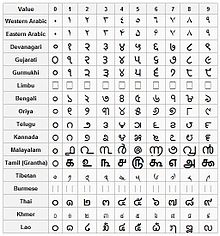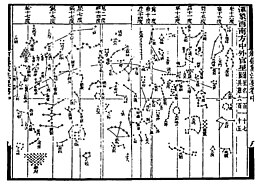User:Willy1018/沙盒/2007年6月30日
物理學史
[编辑]India and China
[编辑]
Important physical and mathematical traditions also existed in ancient Chinese and Indian sciences.

In Indian philosophy, Maharishi was the first to systematically develop a theory of atomism 200 公元前左右[2] though some authors have allotted him an earlier era in the 6th century公元前.[3][4] It was further elaborated by the Buddhist atomists Dharmakirti and Dignāga during the 1st millennium CE.[5] Pakudha Kaccayana, a 公元前6世紀 Indian philosopher and contemporary of Gautama Buddha, had also propounded ideas about the atomic constitution of the material world. These philosophers believed that other elements (except ether) were physically palpable and hence comprised minuscule particles of matter. The last minuscule particle of matter that could not be subdivided further was termed Parmanu. These philosophers considered the atom to be indestructible and hence eternal. The Buddhists thought atoms to be minute objects unable to be seen to the naked eye that come into being and vanish in an instant. The Vaisheshika school of philosophers believed that an atom was a mere point in space. Indian theories about the atom are greatly abstract and enmeshed in philosophy as they were based on logic and not on personal experience or experimentation. In Indian astronomy, Aryabhata's Aryabhatiya (499 CE) proposed the Earth's rotation, while Nilakantha Somayaji (1444–1544) of the Kerala school of astronomy and mathematics proposed a semi-heliocentric model resembling the Tychonic system.
The study of magnetism in Ancient China dates back to the 4th century BCE. (in the Book of the Devil Valley Master),[6] A main contributor to this field was Shen Kuo (1031–1095), a polymath and statesman who was the first to describe the magnetic-needle compass used for navigation, as well as establishing the concept of true north. In optics, Shen Kuo independently developed a camera obscura.[7]
- ^ Click the image to see further details.
- ^ Oliver Leaman, Key Concepts in Eastern Philosophy. Routledge, 1999, page 269.
- ^ Chattopadhyaya 1986,第169–70頁
- ^ Radhakrishnan 2006,第202頁
- ^ (Stcherbatsky 1962 (1930). Vol. 1. P. 19)
- ^ Li Shu-hua, "Origine de la Boussole 11. Aimant et Boussole", Isis, Vol. 45, No. 2. (Jul., 1954), p.175
- ^ Joseph Needham, Volume 4, Part 1, 98.
